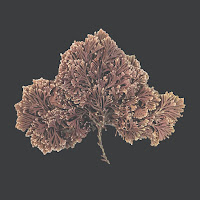ABSTRACT
A molecular and morphological taxonomic study of Corallina (Corallinales, Rhodophyta) from Tristan da Cunha and the Falkland Islands revealed Corallina chamberlainiae J.Brodie & R.Mrowicki sp. nov. from both South Atlantic archipelagos, and Corallina cf. caespitosa only in the Falkland Islands. Analysis of mitochondrial COI-5P and plastid psbA resolved C. chamberlainiae as a distinct clade composed of specimens from Tristan and the Falkland Islands (COI-5P), in addition to two matching New Zealand samples (psbA). In psbA analyses, C. cf. caespitosa was close to two species from Japan (as C. pilulifera and C. melobesioides) but was separate from C. caespitosa sensu stricto from Britain and C. ferreyrae (isotype) from Peru. In COI-5P analyses, C. cf. caespitosa was in a clade with C. caespitosa (holotype) and close to, but distinct from, C. ferreyrae and an unidentified South African Corallina species. Application of the Automatic Barcode Gap Discovery (ABGD) and Poisson tree processes (bPTP) for COI-5P lumped C. chamberlainiae into one clade, whereas the Generalized Mixed Yule Coalescent (GMYC) model split it into two well-supported groups, one of which only contained Falkland Island specimens. All three models lumped C. cf. caespitosa with C. caespitosa. C. chamberlainiae closely resembles C. officinalis, the generitype, but is distinguished by smaller size and a more compressed thallus towards the apex. Corallina cf. caespitosa resembles C. caespitosa but is smaller and has fused, palm-like upper fronds. Neither of these taxa is conspecific with C. ferreyrae although C. caespitosa was recently synonymized with C. ferreyrae. C. chamberlainiae and C. cf. caespitosa occupy similar intertidal habitats to their respective, closely related counterparts C. officinalis and C. caespitosa. The results indicate cryptic diversity and suggest that there are many misidentified Corallina species. The paucity of South Atlantic studies of the Corallinales points to the need for a much greater taxonomic effort in this biogeographic region.
KEY WORDS: COI-5P, cryptic biodiversity, geniculate Corallinales, psbA, South Atlantic, taxonomic relationships
Corallina chamberlainiae J.Brodie & R.Mrowicki sp. nov.
HOLOTYPE: Gough Island, Tristan da Cunha, coll. Sue Scott, 28 Jan 2014, GCORR03, BM013844023, deposited in the Natural History Museum, London, UK (BM) (Fig. 4).
TYPE LOCALITY: Gough Island, Tristan da Cunha: site GL04, Penguin Island Shore.
ETYMOLOGY: The specific epithet is named after Yvonne Chamberlain (1933–2017), a specialist in the taxonomy of the Corallinales, who studied the seaweeds collected from Gough Island by Nigel M. Wace (Chamberlain, 1965).
HABITAT: Marine, growing attached to rock or other crustose coralline algae on the lower shore and sublittoral fringe, on vertical rocks, along the edge of channels and runnels, in rock pools just below the water line, and on upward-facing rock in the shallow subtidal.
DISTRIBUTION: South Atlantic, recorded from Tristan da Cunha (including the main island of Tristan, Nightingale Island and Gough Island), the Falkland Islands (East and West Falkland) and New Zealand (Ahipara, North Island and Wharekauri, Chatham Islands).
Juliet Brodie, Leanne Melbourne, Robert J. Mrowicki, Paul Brickle, Stephen Russell and Sue Scott. 2020. Corallina (Corallinales, Rhodophyta) from Tristan da Cunha and the Falkland Islands: Implications for South Atlantic Biogeography. European Journal of Phycology. DOI: 10.1080/09670262.2020.1780635
Armoured 'slug' among 503 new species described by Museum scientists in 2020







